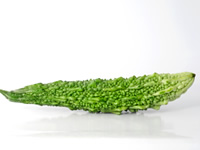
Link: http://www.diabetes.co.uk/natural-therapies/bitter-melon.html
Bitter melon can reduce blood glucose levels but more research is required
Bitter melon, also known as bitter gourd or karela (in India), is a unique vegetable-fruit that can be used as food or medicine.
It is the edible part of the plant Momordica Charantia, which is a vine of the Cucurbitaceae family and is considered the most bitter among all fruits and vegetables.
The plant thrives in tropical and subtropical regions, including:
South America
Asia
parts of Africa
the Caribbean
The bitter melon itself grows off the vine as a green, oblong-shaped fruit with a distinct warty exterior - though its size, texture and bitterness vary between the different regions in which it grows - and is rich in vital vitamins and minerals.
How does it affect diabetes?
In addition to being a food ingredient, bitter melon has also long been used as a herbal remedy for a range of ailments, including type 2 diabetes.
The fruit contains at least three active substances with anti-diabetic properties, including charantin, which has been confirmed to have a blood glucose-lowering effect, vicine and an insulin-like compound known as polypeptide-p.
These substances either work individually or together to help reduce blood sugar levels.
It is also known that bitter melon contains a lectin that reduces blood glucose concentrations by acting on peripheral tissues and suppressing appetite - similar to the effects of insulin in the brain.
This lectin is thought to be a major factor behind the hypoglycemic effect that develops after eating bitter melon.
Scientific evidence
A number of clinical studies have been conducted to evaluate the efficacy of bitter melon in the treatment of diabetes.
Bitter Melon on the Diabetes Forum

Karela bitter melon tablets
Bitter Melon/Kerala Fruit
Cinnamon and Bitter Melon for reducing fasting levels
Bitter melon
Bitter melon extract
In January 2011, the results of a four-week clinical trial were published in the Journal of Ethnopharmacology, which showed that a 2,000 mg daily dose of bitter melon significantly reduced blood glucose levels among patients with type 2 diabetes, although the hypoglycemic effect was less than a 1,000 mg/day dose of metformin. [68]
Other older studies have also suggested an association between bitter melon intake and improved glycemic control, while a report published in the March 2008 issue of Chemistry and Biology found that bitter melon increased cellular uptake of glucose and improved glucose tolerance. [69]
However, research published in the Journal of Clinical Epidemiology in 2007 failed to show any benefits of bitter melon for poorly controlled type 2 diabetes, while another clinical review published two years later in the British Journal of Nutrition stated that more, better-designed and clinical trials are required to confirm the fruit’s role in diabetes treatment. [70]

Karela bitter melon tablets
Bitter Melon/Kerala Fruit
Cinnamon and Bitter Melon for reducing fasting levels
Bitter melon
Bitter melon extract
In January 2011, the results of a four-week clinical trial were published in the Journal of Ethnopharmacology, which showed that a 2,000 mg daily dose of bitter melon significantly reduced blood glucose levels among patients with type 2 diabetes, although the hypoglycemic effect was less than a 1,000 mg/day dose of metformin. [68]
Other older studies have also suggested an association between bitter melon intake and improved glycemic control, while a report published in the March 2008 issue of Chemistry and Biology found that bitter melon increased cellular uptake of glucose and improved glucose tolerance. [69]
However, research published in the Journal of Clinical Epidemiology in 2007 failed to show any benefits of bitter melon for poorly controlled type 2 diabetes, while another clinical review published two years later in the British Journal of Nutrition stated that more, better-designed and clinical trials are required to confirm the fruit’s role in diabetes treatment. [70]
What other health benefits does it have?
Bitter melon is used in traditional medicine for:
Colic
Fever
Burns
Chronic cough
Painful menstruation
Skin conditions
It is also used to heal wounds, assist childbirth and, in parts of Africa and Asia, prevent or treat malaria and viral diseases such as measles and chicken pox.
In addition, researchers from Saint Louis University in the US say they have shown that an extract from bitter melon can kill breast cancer cells and prevent them from growing and spreading.
~~~~~~~~~
From a ex-domestic helper of mine who came from the Philippines: Bitter Gourd leaves use for healing wounds. Steaming the leaves and then applying on to the wounds seem to promote healing.
From words of mouth: Bitter gourd cleanses blood and lower blood pressure.
And thank goodness that I love them!
Cheers all
Om Guru Lian Sheng Siddhi Hom
Lama Lotuschef



No comments:
Post a Comment